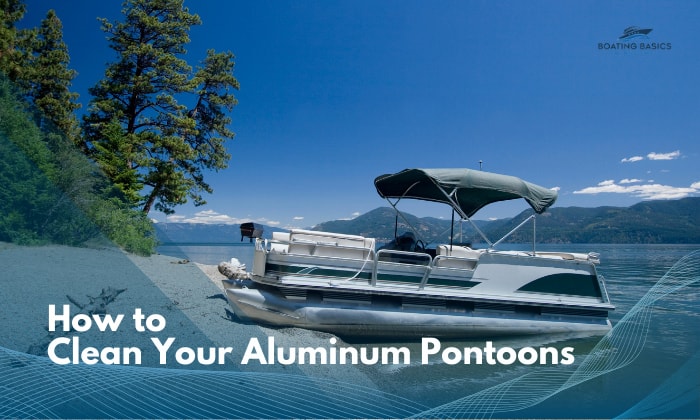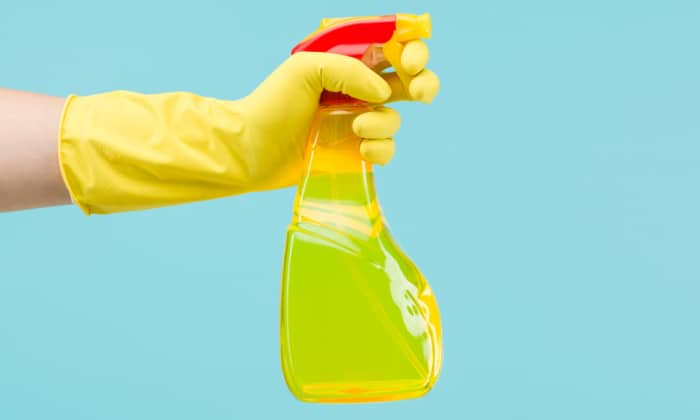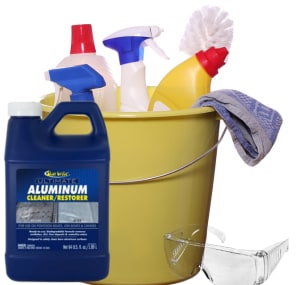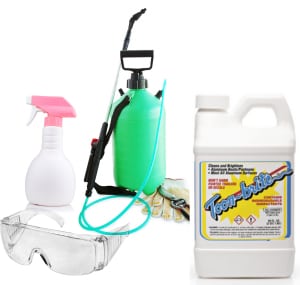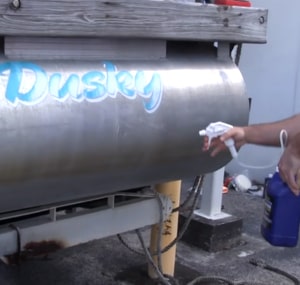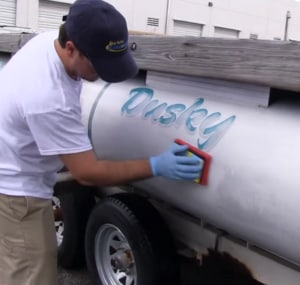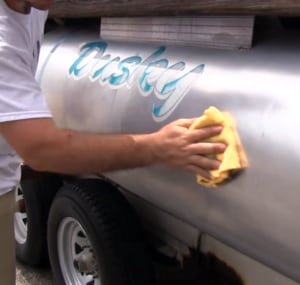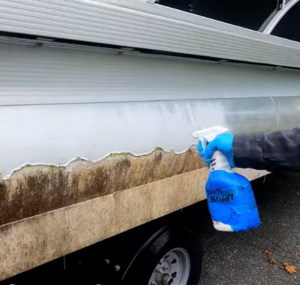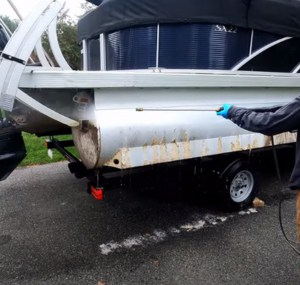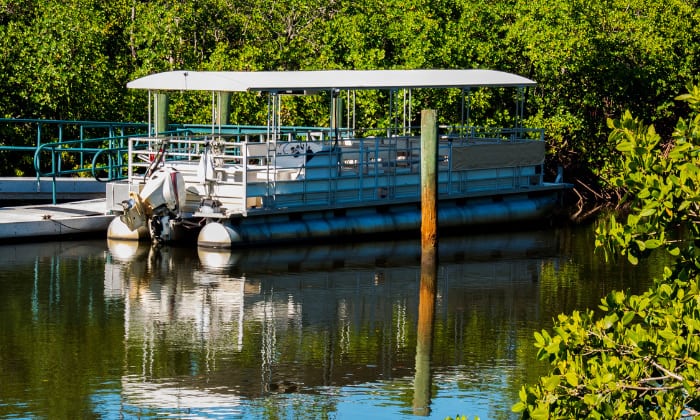If you haven’t done it already, I encourage you to learn how to clean your aluminum pontoons. The more I did it over the years, the more I realized how much money I saved. More importantly, my babies remain spick and span.
In this guide, I’ve outlined my methods for removing oxidation, algae, scum, and other buildups. The best way depends on if you want cheap and convenient or more thorough cleaning. I tend to just switch between these two methods.
Read on so you can learn all the cleaning tips that will make your life easy.
Table of Contents
What to Prepare Based on Every Cleaning Method
1. Cleaning with a scrubber pad
- Aluminum cleaner (I recommend using Star Brite aluminum cleaner)
- Star Brite aluminum polish
- Sprayer
- Acid-resistant gloves
- Safety glasses
- Scrubber pad
- Polishing cloth or pontoon polishing kit
- Water hose
2. No scrubbing (aka the lazy way – which I love!)
- Toon-brite cleaner
- Sprayer
- Pressure washer
- Acid-resistant gloves
- Safety glasses
Overall, the steps are essentially the same for both methods. Sometimes, I need to use a brush or scrubber pad if the buildup’s stubborn or I want a more thorough pontoon boat cleaning. It’s a matter of doing an eye test and determining whether you need it or not.
Steps on How to Clean Aluminum Pontoons
Before starting either method, put on your gloves and safety glasses.
Scrub method
1. Insert the sprayer into the can of aluminum cleaner then apply even coats.
Star Brite comes with its sprayer, so you just need to open the bottle, then insert the sprayer into it. Use the fine mist spray setting.
I usually apply the cleaner starting from the bottom and then working my way upward for every section. This is so there won’t be drip marks.
Two sprays with two even strokes are enough. You should start noticing foams which indicate that the product’s taking care of oxidation and growth.
2. Start scrubbing then rinse with water once done.
We want to clean pontoon boat sides thoroughly, so grab the pad and start brushing. We’re aiming to maximize the coverage of the cleaner we’ve applied while making sure that it’s even.
Apply a bit of pressure while you’re scrubbing so that the cleaner can get to the parts with heavier oxidation.
Once you get good coverage and cleaning, you can now rinse the surface using the water hose.
You need to perform these steps on one side without interruption as letting the cleaner dry on the surface will lead to etching and discoloration.
3. Apply the polish.
Once the surface is dry, grab the polishing cloth then dab some polish on it. Follow how much you need to use based on the instructions.
Start wiping the polish onto the cleaned surface. This will trigger further removal of oxidation, which will likely cause the cloth’s color to change.
Finished? Start buffing the surface with a clean, dry cloth.
I highly recommend getting the polish as it does result in an eye-catching finish every time.
No scrubbing method
Most of the time, I tend to just do this method because I see a marginal difference when compared to the results in the first method.
1. Put the cleaner in the sprayer, then apply an even mist on the buildup.
This is a lot like the first step above. Just put enough cleaner in any spray bottle or sprayer you have at your disposal.
Afterward, apply it. Aim to coat every area and nook and cranny that has dirt and oxidation.
Work from the bottom up, the same as the tip I shared. Done? You now have to let the boat “rest” for at least 5 minutes before proceeding to the next step. Don’t let it dry, though!
2. Start blasting the gunk with water.
Turn on the pressure washer then hose down the remaining growth that the cleaner hasn’t already taken care of.
Take note: You don’t have to perform Steps 1 and 2 at one time. It’s better to work in sections, especially if you have a sizable vessel so that the cleaner won’t dry and cause the problems above.
So feel free to alternate doing steps 1 and 2 until the entire surface is nice and spotless.
And that’s all there is to it, really! I love the Toon-brite product as a cleaner for pontoon toons because it eliminates some of the steps without sacrificing quality results.
Other Proven Cleaners You Can Try Out and Tips to Remember
- A couple of my boating buddies get behind the Algex pontoon cleaner, but I can’t comment on how good it is yet, since I haven’t tried it. Plenty of pontoon owners like it, though.
- A product like Napa aluminum brightener is made for wheels rather than boats, so it may not be the best choice.
- You can also do the task with vinegar and water. A mixture of 30% vinegar with 70% water can be used as an effective acid wash aluminum pontoons solution.
- Clean pontoons in the water only if you just want to take off the algae and other gunk, not so much if you have to deal with oxidation issues.
- I don’t suggest cleaning with toilet bowl cleaner, especially if you won’t use polish. You’ll only get a dull, zero-shine surface every time. Plus, you’re not really sure how harsh the chemicals in them are.
The best I can recommend for an aluminum pontoon cleaner homemade option is the vinegar/water mix, especially if oxidation is not a problem yet. You have to use a genuine pontoon boat cleaner for that, so you won’t have any regrets later on.
Conclusion
Overall, cleaning aluminum pontoons is not at all a lengthy process. You just have to be willing to put some elbow grease in if you want a shinier finish. But if your boat’s already shiny enough as it is, you can save yourself loads of time by opting for the no-scrub method.
Anyway, now that you know how to clean your aluminum pontoons, trust me, you’ll only thank yourself more for doing so. I know I did once I started to save extra dough I can spend on something more worthwhile and when my pontoons passed the 8-year mark.

“My intention from the first day establishing Boating Basics Online is to provide as much help as possible for boaters who want to experience a first safe and convenient trip. So feel free to join us and share your beautiful journeys to the sea!”

